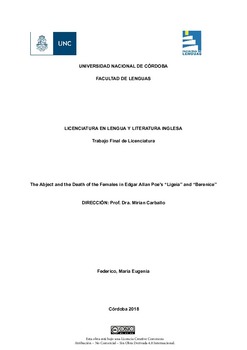| dc.contributor.advisor | Carballo, Mirian | |
| dc.contributor.author | Federico, María Eugenia. | |
| dc.date.accessioned | 2019-10-10T14:17:37Z | |
| dc.date.available | 2019-10-10T14:17:37Z | |
| dc.date.issued | 2018 | |
| dc.identifier.uri | http://hdl.handle.net/11086/12893 | |
| dc.description.abstract | The stories inscribed in the Gothic period have become a source for readers to have access to mysterious events and eerie circumstances that, through an intimate view into the relationship between the living and the dead/undead, reveal a deeper meaning of personal, social and cultural concerns. In the stories “Ligeia” (1838) and “Berenice” (1835), Edgar Allan Poe describes the agonizing death of young beautiful females, which stirs a morbid and romantic interest in readers. In these stories, the lover is an observer of the beloved’s death who becomes aware of the presence of death in life. The woman who agonizes and dies turns into a disturbing force which threatens the man’s understanding of life and death. | es |
| dc.language.iso | eng | es |
| dc.rights | Attribution-NonCommercial-NoDerivatives 4.0 Internacional | * |
| dc.rights.uri | http://creativecommons.org/licenses/by-nc-nd/4.0/ | * |
| dc.subject | Poe, Edgar Allan, 1809-1849 | es |
| dc.title | The abject and the death of the Females in Edgar Allan Poe's "Ligeia" and "Berenice" | es |
| dc.type | bachelorThesis | es |





